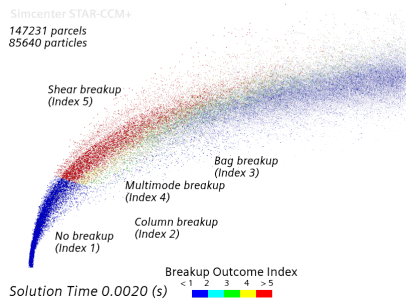As usual when the temporal discretization of current eon allows for small time steps to reach the relevant Wednesday, we wait! That relevant Wednesday that is reached three times a year, which is associated with the release of a new version of Simcenter STAR-CCM+, and then we look at what news are provided. As it so happens, this last Wednesday was the release of Simcenter STAR-CCM+ version 2210. The second main release following the new naming convention for the software.
We will in this post look at my favourite subject in the vast multiphysics tool that is Simcenter STAR-CCM+, namely the fickle world of multiphase simulations. This post will contain the news for both the Eulerian framework, the Lagrangian framework, and with extension also the DEM. The reason for this is that there has not been a large focus on multiphase news in this version. But what is there is still as interesting.
Eulerian multiphase (EMP)
The input required for the Maximum Packing Condition adaptive time-step provider for EMP granular flows in previous releases was the Target Max. Volume Fraction property. The most suitable values for this parameter were very problem specific and depended on the frictional model chosen and the maximum packing. To avoid the user having to provide case-specific input, this property has now been replaced with a new expert property Threshold Frictional Solid Pressure which does not typically need to be changed.
The default setting for Interaction area density has been changed from Spherical particle to symmetric for multiple flow regimes for consistency with other flow topologies (continuous-dispersed) and to reflect best practices.

Volume of fluid (VOF)
Volume fraction residual for VOF implicit multi-step has been made consistent with the single-step definition. Previously when switching methods between single-step and multi-step you would have observed a jump in volume fraction residual level despite no change in the relative level of convergence. As such the multi-step volume fraction residual was misleading. This has now been fixed by changing the definition of volume fraction residual to be based on the average sub-step residual over the flow time-step.
Lagrangian Multiphase (LMP)
For this version a user-defined secondary breakup model is now available. The current models available for secondary breakup (SSD, TAB, Reitz-Diwakar, KHRT) do not always produce acceptable accuracy for the size distribution of droplets in the case of liquid fuel spray in crossflow. For simulating combustors in gas turbines, for example, it is difficult to get an accurate prediction for both mean temperature and maximum temperature at the outlet and this inaccuracy is often the consequence of the inaccuracy of the breakup modelling. So, for version 2210 now a model is introduced where the user is allowed to reproduce any existing breakup model from literature. The implemented solution allows the user to specify an arbitrary number of the breakup outcomes and then input the breakup map using field function or table input method. The breakup map specifies the conditions for each breakup outcome. The animation below shows an example of using the user-defined breakup model with five possible outcomes (no breakup, column breakup, shear breakup, bag breakup and multimode breakup).
DEM
Three improvements have been made to get accurate results and easily set up simulations and analyze DEM moments and forces on geometry parts:
- DEM Moment and DEM Force reports. The animation below shows an example use case, mixing granular materials. Here the torque on the rotating turbine of the mixer is obtained using the new DEM moment report.
- Average Moment option in DEM Boundary Accumulation model. The user now has access to the new field function which returns the values of the moment on each face of the part.
- Improved accuracy of DEM Moment used in DFBI Body Moment calculation. The updated algorithm for calculating DEM moment provides the benefit of reduced surface mesh dependency. Previously surface remeshing operation was recommended to get accurate solution for the DEM moment on the DFBI body, but this recommendation is no longer needed.
Since the introduction of the flexible fibers model a few releases back some improvements has been made, and this is also true for version 2210. The introduction of Damping forces in flexible fibers allows for more accurate simulations of flexible fibers. The introduction of the velocity damping physics at the location of the bonds between fiber segments now provides two benefits for users simulating flexible fibers:
- Simulations with damping are more stable, including when running at larger DEM timestep. This is because the feature provides an effective mechanism for reducing or eliminating the non-physical relative displacement of segment ends at each bond between segments.
- Improved accuracy and realism. Previously the oscillations of the deformed fibers continued indefinitely if no energy dissipative interactions with fluid, other fibers or geometry are taking place, see the animation below.
The snip below also shows the two new parameters that users specify to control the level of energy damping at the bonds, the axial and bending restitution coefficients.

The last DEM news, and also the last multiphase news for this version, is the introduction of the ability to account for particle-wall collisions in particle damage analysis. The first part of particle damage analysis was introduced in version 2021.2. From there users were provided a tool for integrating particle-particle contacts and storing the results of integration on particles. In this version now also the integration of particle-wall contacts is possible. This new feature is important for improving the design of the bulk material handling and processing equipment while keeping the particle attrition under control. For example, it is useful for improving the design of cyclones by minimizing the damage to catalyst particles. The animation below shows the result of simulating segregation by particle size in a standard reverse flow cyclone feeding larger size catalyst particles back into a fluidized bed reactor through a dipleg.
I hope these new features can help you when running your Simcenter STAR-CCM+ analyses from version 2210 and onward. As usual, do not hesitate to reach out if you have any questions to support@volupe.com.
Author

Robin Victor
+46731473121
support@volupe.com




